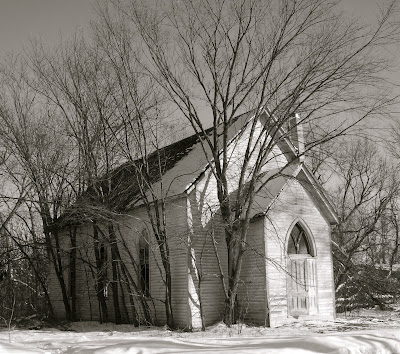
One of my lifelong, best friends, JW - who affectionately brags of "having known me since I was a fetus" - recently moved some of his life to the semi-abandoned "ghost town" of Lac qui Parle, Minnesota.

Just a few dozen miles from the South Dakota border, the semi-abandoned village may have been one of the possible original choices for the pre-state, territorial Minnesota capitolship, and prominently displays a sign bragging of its' Post Office roots.

Very little history can be found on-line, and the winter hours of the local historical society make it unrealistic to dig into archives when it isn't warm.
But the town seems poised on the verge of fading into the prairie, and that troubles me.
Specifically, there is an old church, pictured here and in my blog's title, that seems close to being a loss forever.

Many people have no trouble with that, and find old, decaying structures or objects "eyesores," and worthy of burial.
I'm just the opposite, and have found a stunning beauty in that decay, but mainly for the history behind it.
I have elicited the help of some of my Flickr photoshop wizards to try and decipher the NAME of the church, which is all but illegible. I could only make out "church" and "synod," and a few Flickr-ites found "Ev Luth" and "John" in the battered wood with extensive digitizing, maybe even a "St." before the John.
The Minnesota State Historical Society has one photo of the church, from 1971, although they list as the Lac qui Parle 'Union Church."
I took several dozen photos in and out of the church, but one of the more stunning features is a nearly century old wood stove (shown here) that I was able to trace back to at least 1912!


Next on the order was genealogical society records, which seem to indicate little about the church, but may reference a cemetery near the site - which I couldn't see through the four-foot-tall snowdrifts. However, that is a game changer, and if a cemetery is "lost," it MUST be noted or reclaimed for protection, by many state statutes.
If that "lost" cemetery is for real, it may indicate the church had an actual congregation until no later than 1922, before pulling up stakes when the village fell apart.
Regardless, the biggest threat to this once amazing structure is obvious: The former landscaping trees that lined its flanks!
Imagine, one hundred years ago, a group of dedicated people did their best to beautify the plain-sided church, and "pretty it up" with some bushes, or shrubs and small trees from their clippings. Those trees/shrubs/bushes are now over thirty feet tall, and growing through the walls and windows, threatening the old church more than the elements, development, critters or even other denominations!
JW and a few of us who moved helped move him have discussed a "save the church" weekend, where we bring our chainsaws, trailers and formidable muscles in to cut those offending trees back and give the church - and possible cemetery - a new chance.
It would be a cool retreat, or shop, or showroom, or ski/snowmobile/ATV stop, or yes, Brother JW, again as a church.
It would be a cool retreat, or shop, or showroom, or ski/snowmobile/ATV stop, or yes, Brother JW, again as a church.
As Lac qui Parle's newest resident put it, he's hoping the church returns the favor.






No comments:
Post a Comment